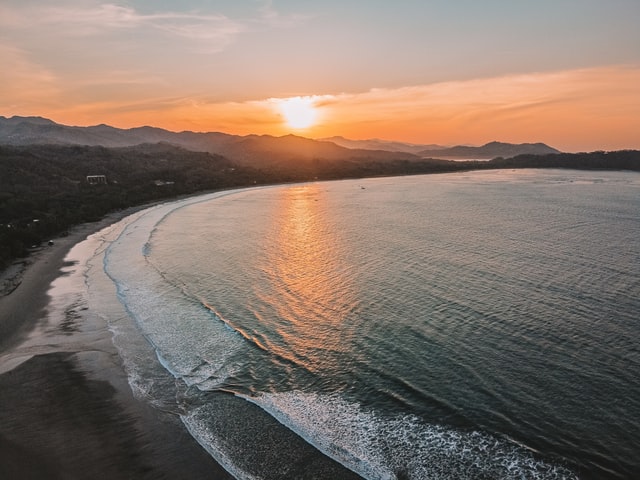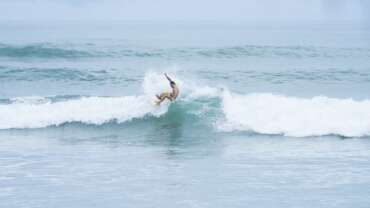Sun & Beaches in Costa Rica
Costa Rica: The paradise for the sun lovers
Costa Rica occupies a privileged place in the heart of Central America for the richness of its beaches, comprises 1,228 km of coastline, of which 1,016 km are from the Pacific coast and 212 km in the Caribbean Sea, you are separated by just three hours in vehicle or 45 minutes by air from San José. It is estimated that 600 beaches surround the entire national territory.
This wealth allows the enjoyment of the beach as a means of recreation, sport and rest. These are wooded beaches, with natural spaces and relatively little influx of tourists.
The Caribbean region stands out for its variety of marine ecosystems and its white- and black-sand beaches, ideal for activities centered around nature and the ocean, including surfing, diving in clear water, basking in the sun and hiking along the coast.
The Pacific coast contains major tourism centers and beaches that are favorites among surfers, including Esterillos, Jacó, Hermosa, Boca Barranca, as well as the Pavones Sector and the surroundings of the Marino Ballena National Park, with its famous long left wave.
Near the beach areas you will find a wide variety of options to stay and taste Costa Rican cuisine. Among the variety of hotels you can enjoy are: all inclusive option, honeymoon hotels, eco resort, family hotels, 5 star hotels, Spa & Wellness, etc. In addition to the typical food you can also enjoy restaurants that specialize in international dishes.
When visiting any beach in Costa Rica, keep the following security precautions in mind:
Take care of your belongings while enjoying the sea or leave them somewhere they can be watched.
Always use sunscreen to avoid burns on your skin.
When possible, do not swim on your own and consult the authorities regarding beach conditions.
Be aware of warning flags on the beach.
Do not enter the ocean if you do not know how to swim. If surfing as a beginner, always be accompanied by an instructor.
About Costa Rica’s beaches
GUANACASTE
The beaches located in the Guanacaste area offer adventure,recreation, and a wide variety of activities. Sunbathers enjoy radiant sunshine almost all year round. If you prefer something more secluded, , there are small boutique hotels near Santa Elena Peninsula, or larger hotel compounds located near the Gulf of Papagayo.
CENTRAL & MID PACIFIC
Visitors have their choice of perfect beaches for sunbathing, swimming, snorkeling, sailing, or just enjoying walking through the forest.The central region also features fun places, like puntarenas, with its giant cruise ships on the pier, and famous seafood, including dishes like ceviche, a delicious dish made from fresh raw fish marinated in citrus juices. The middle pacific offers exuberant landscapes where sun, beach and forests combine in national parks such as manuel antonio and marino ballena. If you’re looking for excitement, the beaches of jaco and hermosa have ideal conditions for surfing. In the evening, the fun continues late into the night and all the beaches have comfortable accommodations available.
SOUTH PACIFIC
This region of Costa Rica combines everything you like about the beach, including the pristine vegetation and coral reefs of the island of Caño, perfect for snorkeling and snorkeling. You should also make time to discover the breath-taking beaches of Golfo Dulce and the Osa Peninsula, protected by Biological Reserves and the National Park of Corcovado. Perfect for fishing, surfing or just admiring wildlife like the marvelous macaw, these beaches are easily accessible thanks to local flights originating from Golfito and Puerto Jimenez.
SOUTH CARIBBEAN
Accessible by land, beautiful beaches await you in this region of Costa Rica. The contrast of the white and black sand beaches of Cahuita and Puerto Viejo are unforgettable, whether surfing, fishing, or diving on spectacularly colorful coral reef. A rich and strong afro-caribbean influence welcomes visitors to learn about the particular culture and architecture of the region, the vibrant spirit of its people, and the wonderful, authentic flavor of dishes such as rice and beans, pati, plantinta, chicken with coconut, and rondon.
ISLANDS
Although it seems incredible, Costa Rica has more than one hundred islands, most of them with little tourist visitation, because they are protected by the Conservation Area System. Some of them resonate more because visitation is allowed and some companies provide services to tourists. They are striking for their richness in flora and fauna and also for activities such as: diving, snorkeling, boat rides, hiking, whale watching tours, dolphins and turtles.
Isla del Caño is one of them, it is a biological reserve located in the Pacific of the country, about 16 km northwest of the Osa Peninsula, Puntarenas. This island consists of 320 hectares of land and 5,800 marine. It has one of the largest and best condition coral formations in the Pacific Coast of the country. Day trips can be organized from Dominical, Drake Bay, Uvita and Sierpe. There are several companies in Uvita that offer these tours. Between July and October, the humpback whales that migrate from the Southern Hemisphere (Patagonia) arrive to our Central and South Pacific, covering more than 8000 km, some of these can be observed near Isla del Caño.
Another of the most visited islands for its proximity and attraction, is Isla Tortuga. This wonderful island is located in front of the southeast coast of the Nicoya Peninsula and can only be accessed by boat. The tours are only one day, since there is no hotel service on the island, this allows the attractiveness of the place to be protected. You can opt for different activities such as: snorkeling, kayaking, nature walks, beach volleyball, and even more different activities and sports such as jet ski, banana boat, paddle board and kayaks.
SNORKELING
For lovers of water sports and fun activities, they will find in snorkeling a way to explore the different beaches of Costa Rica. This activity is characterized by the use of a diving mask and a breathing tube called snorkeling, sometimes diving fins are also used on the feet. If you want to vacation in the Caribbean, you can choose to practice it in Cahuita, Cocles, Punta Uva and Manzanillo. In the case of Puntarenas, they can practice it in places such as: Tortuga Island, Caño Island, Drake Bay, Uvita, Quepos, Manuel Antonio National Park, Montezuma Beach, among other places. In the Guanacaste area you can do this activity in places such as: Hermosa Beach, Coco Beach, San Juanillo, Chora Island, Ocotal, Conchal, Nacascolo, Potrero, among others. It is important that although the company has a protocol of security measures, the tourist is attentive to the tide, to identify a strong swell and to be aware that it is essential to know how to swim to perform the activity.






